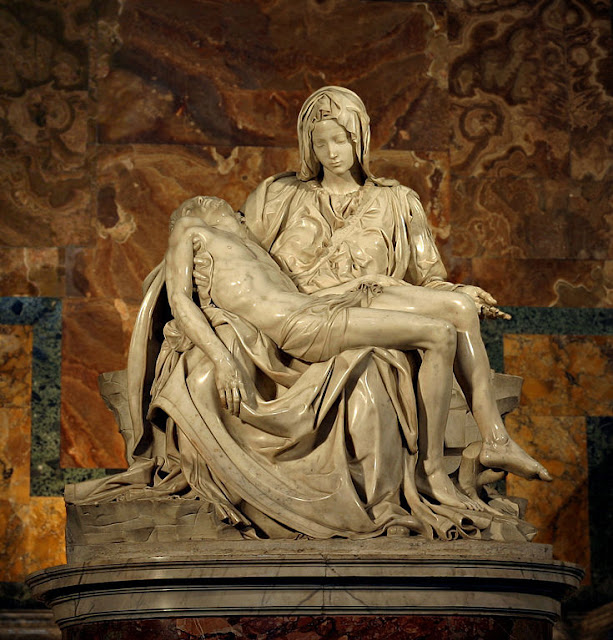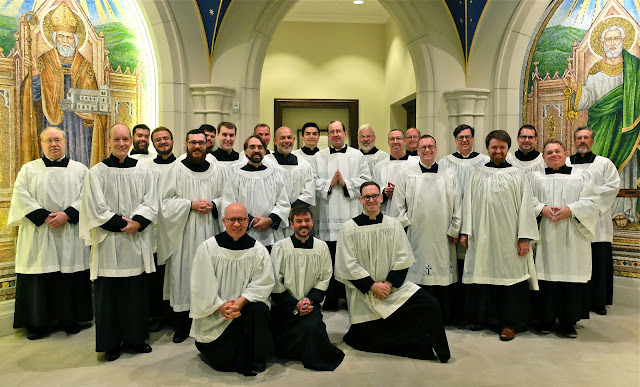Rogation Days - Monday, Tuesday & Wednesday before Ascension Thursday.
Material adapted or cited verbatim from:
The Catholic Encyclopædia
The Catholic Encyclopædia
Fish Eaters
The Litany (p.1061: Divine Worship: the Missal)
Antiphon 19.2 (2015) 116–131 A Missal for the Ordinariates: The Work of the Anglicanae Traditiones Interdicasterial Commission, by Steven J. Lopes; p. 129-130.
The Litany (p.1061: Divine Worship: the Missal)
Antiphon 19.2 (2015) 116–131 A Missal for the Ordinariates: The Work of the Anglicanae Traditiones Interdicasterial Commission, by Steven J. Lopes; p. 129-130.
- - -
Rogation days are days of prayer, and formerly also of fasting, instituted by the Church to appease God's anger at man's transgressions, to ask protection in calamities, and to obtain a good and bountiful harvest, known in England as "Gang Days" and "Cross Week", and in Germany as Bittage, Bittwoche, Kreuzwoche.
Rogation days are days of prayer, and formerly also of fasting, instituted by the Church to appease God's anger at man's transgressions, to ask protection in calamities, and to obtain a good and bountiful harvest, known in England as "Gang Days" and "Cross Week", and in Germany as Bittage, Bittwoche, Kreuzwoche.
Rogation days are observed with processions and the Litany. The word rogation comes from the Latin verb rogare, meaning "to ask", which reflects the beseeching of God.
The Minor Rogation Days are of French origin, coming about in the 5th c., when St. Mamertus, Bishop of Vienne, Dauphiné instituted them after a series of natural calamities. According to the Golden Legend:
For then, at Vienne, were great earthquakes of which fell down many churches and many houses, and there was heard great sounds and great clamours by night. And then happened a terrible thing on Easter-day, for fire descended from heaven that burnt the king's palace. Yet happened more marvellous thing; for like as the fiends had entered into the hogs, right so by the sufferance of God for the sins of the people, the fiends entered into wolves and other wild beasts, which every one doubted, and they went not only by the ways near by the fields, but also by the cities ran openly, and devoured the children and old men and women. And when the Bishop saw that every day happened such sorrowful adventures, he commanded and ordained that the people should fast three days; and he instituted the Litanies, and then the tribulation ceased.
The observance of the Minor rogation days was ordered by the Council of Orleans in 511, and though the practice was spreading in Gaul during the 7th century, it was not officially adopted into the Roman rite until the reign of Pope Leo III.
The faithful typically observed the rogation days by fasting and abstinence in preparation to celebrate the Ascension, and farmers often had their crops blessed by a priest at this time. Violet vestments are worn at the Rogation Litany and its associated Mass, regardless of what colour is worn at the ordinary liturgies of the day.
The Rogation Days are the 25th of April, called Major, and the three days before the feast of the Ascension, called Minor. The Christian Major rogation replaced a pagan Roman procession known as Robigalia, at which a dog was sacrificed to propitiate Robigus, the deity of agricultural disease. The practitioners observing Robigalia asked Robigus for protection of their crops from wheat rust.
The Rogation Day ceremonies are thought to have arrived in the British Isles in the 7th century. The rogation days were highly esteemed in England. Their celebration continued even to the thirteenth year of Elizabeth, 1571, when one of the ministers of the Established Church inveighed against the Rogation processions, or Gang Days, of Cross Week. The ceremonial may be found in the Council of Clovesho (Thorpe, Ancient Laws, I, 64; Hefele, Conciliengeschichte, III, 564).
The oldest known Sarum text regarding rogation days is dated from around 1173 to 1220. In it, celebrations in the south of England are described, in which processions were led by members of the congregation carrying banners which represented various biblical characters. At the head of the procession was the dragon, representing Pontius Pilate, which would be followed by a lion, representing Christ. After this there would be images of saints carried by the rest of the congregation. Many torches were present at each procession.
Sarum texts from the 13th and 15th centuries show that the dragon was eventually moved to the rear of the procession on the vigil of the Ascension, with the lion taking the place at the front. Illustrations of the procession from the early 16th century show that the arrangements had been changed yet again, this time also showing bearers of reliquaries and incense.
- - -
Rogation Days
Monsignor (now Bishop) Steven J. Lopes
In light of what has just been noted about the Ember Days, a word about Rogation Days seems in order. The practice of setting aside particular days marked by processions and prayers for divine assistance began in Gaul and was appropriated for the rest of the Western Church by the Council of Orleans in 511. The Carolingian liturgical reform gathered the so-called “lesser” rogation litanies and stabilized them as a triduum preceding Ascension Day, without the obligation of fasting. In the history of the Roman Rite, there has been some vacillation regarding the character of these days: the Rogation Days have at some points had and at other points not had a penitential character, a discrepancy that was also to be found in the Anglican sources as well. The tension arises over the placement of days of penitential character (requiring purple vestments omission of the Gloria and Alleluia) within Easter.13 Divine Worship: The Missal maintains the Rogation Days in their traditional Roman location preceding Ascension. However, since the liturgical context for these days of particular prayer is the celebration of the Resurrection of the Lord, white vestments are worn and Glorias and Alleluias are not to be omitted.
13 This tension would not be resolved until the reform of the Roman Missal initiated by Pope Pius XII. A few years prior to being appointed Archbishop of Milan in 1929, Blessed Ildefonso Schuster addressed the question of the Rogation Days in this way: “The penitential observance…marked in the Roman Missal by the purple vestments and the omission of the Gloria in excelsis is, however, at variance with the whole spirit of the ancient paschal liturgy at Rome, which is inspired by the purest joy and gladness. It is a later addition, made at a time when the barbarian invasions had interrupted the ancient classical tradition, which by order of the Councils had forbidden any fast whosoever during the holy time of paschal rejoicing.” Ildefonso Schuster, The Sacramentary (Liber Sacramentorum): Historical and Liturgical Notes on the Roman Missal, trans. Arthur Levelis-Marke, Volume II (Parts 3 and 4) (New York: Benzinger, 1925) 356.
- - -
Update 8.5.18
Fr Lee Kenyon, former Dean of the Deanery of St John the Evangelist and former pastor of the Calgary Ordinariate, has posted on the Rogation procession:
All who take part in the procession - and it should include all the congregation - will meet in Church for a few initial prayers and, if desired, a hymn. As it is extremely difficult to sing hymns in an outdoor Procession, psalms and litanies should be chosen in preference or hymns sung by a few voices with a popular refrain in which all may join. Psalms ciii, civ, cxiv, and cxv, the Lent and Advent proses in the English Hymnal, the Prayer Book Litany, and some metrical Litany will be found suitable. When the Procession returns to the Church, a hymn, collect, and blessing might terminate the service.
The most convenient order of Procession will be as follows: Verger with mace, Churchwardens with staves, Cross-bearer, Servers with lanterns on poles, Priest, Banner-bearer and the Passiontide or some very simple banner, members of the congregration in fours, Choir boys, Chanters, Choir men, Clergy in choir habit, and the remaining members of the congregation'.
- - -
Rogation Days
Monsignor (now Bishop) Steven J. Lopes
In light of what has just been noted about the Ember Days, a word about Rogation Days seems in order. The practice of setting aside particular days marked by processions and prayers for divine assistance began in Gaul and was appropriated for the rest of the Western Church by the Council of Orleans in 511. The Carolingian liturgical reform gathered the so-called “lesser” rogation litanies and stabilized them as a triduum preceding Ascension Day, without the obligation of fasting. In the history of the Roman Rite, there has been some vacillation regarding the character of these days: the Rogation Days have at some points had and at other points not had a penitential character, a discrepancy that was also to be found in the Anglican sources as well. The tension arises over the placement of days of penitential character (requiring purple vestments omission of the Gloria and Alleluia) within Easter.13 Divine Worship: The Missal maintains the Rogation Days in their traditional Roman location preceding Ascension. However, since the liturgical context for these days of particular prayer is the celebration of the Resurrection of the Lord, white vestments are worn and Glorias and Alleluias are not to be omitted.
13 This tension would not be resolved until the reform of the Roman Missal initiated by Pope Pius XII. A few years prior to being appointed Archbishop of Milan in 1929, Blessed Ildefonso Schuster addressed the question of the Rogation Days in this way: “The penitential observance…marked in the Roman Missal by the purple vestments and the omission of the Gloria in excelsis is, however, at variance with the whole spirit of the ancient paschal liturgy at Rome, which is inspired by the purest joy and gladness. It is a later addition, made at a time when the barbarian invasions had interrupted the ancient classical tradition, which by order of the Councils had forbidden any fast whosoever during the holy time of paschal rejoicing.” Ildefonso Schuster, The Sacramentary (Liber Sacramentorum): Historical and Liturgical Notes on the Roman Missal, trans. Arthur Levelis-Marke, Volume II (Parts 3 and 4) (New York: Benzinger, 1925) 356.
- - -
Update 8.5.18
Fr Lee Kenyon, former Dean of the Deanery of St John the Evangelist and former pastor of the Calgary Ordinariate, has posted on the Rogation procession:
All who take part in the procession - and it should include all the congregation - will meet in Church for a few initial prayers and, if desired, a hymn. As it is extremely difficult to sing hymns in an outdoor Procession, psalms and litanies should be chosen in preference or hymns sung by a few voices with a popular refrain in which all may join. Psalms ciii, civ, cxiv, and cxv, the Lent and Advent proses in the English Hymnal, the Prayer Book Litany, and some metrical Litany will be found suitable. When the Procession returns to the Church, a hymn, collect, and blessing might terminate the service.
The most convenient order of Procession will be as follows: Verger with mace, Churchwardens with staves, Cross-bearer, Servers with lanterns on poles, Priest, Banner-bearer and the Passiontide or some very simple banner, members of the congregration in fours, Choir boys, Chanters, Choir men, Clergy in choir habit, and the remaining members of the congregation'.

.jpg)





Comments
Post a Comment
Your comments will be appreciated and posted if 1) they are on topic and 2) preserve decorum.
Stand by your word. Do not be anonymous. Use a pseudonym.